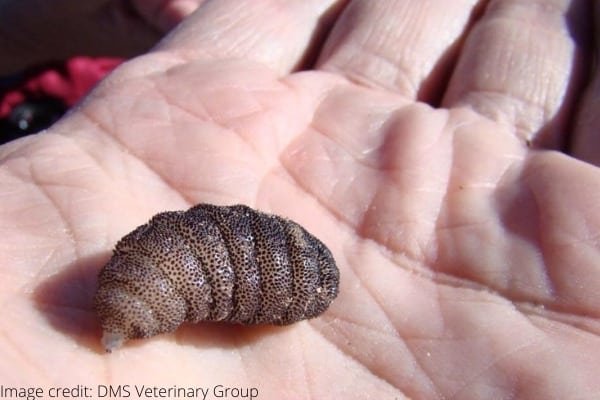
Wolf worm larvae actually come from a type of fly called the Cuterebra. They typically target rodents like mice and squirrels, burrowing into their bodies and causing various issues. If you’re a pet owner, wildlife enthusiast, or simply curious about nature, understanding how to control these larvae can be crucial. In this article, we’ll dive deep into why wolf worm larvae matter and how to manage or prevent infestations effectively.
What Are Wolf Worm Larvae?
Wolf worm larvae, or Cuterebra, are the larval stage of a particular species of flies. They develop inside the bodies of small mammals, often rodents, which creates a unique problem for the furry hosts. You might think of them as tiny invaders; once they enter a rodent, they begin feeding off the host’s tissues. This can lead to significant health issues for the rodent, including infections and even death if not managed.
These larvae are usually found in warmer months. They lie in wait, hoping to find a host. When a rodent comes close, the larvae attach and start their journey inside. This is why understanding the life cycle of wolf worm larvae is essential—it’s all about timing and knowing when to take action.
Why Should You Care About Wolf Worm Larvae?
You might be wondering why wolf worm larvae should even be on your radar. Well, if you’re involved in pet care, wildlife rehabilitation, or simply have an interest in local rodent populations, knowing about these larvae is vital. Rodents play a big role in our ecosystem, and when these larvae affect their health, it can throw off the balance.
Rodents can also be carriers of diseases that can affect humans and pets. If they’re unhealthy due to wolf worm larvae infestations, there’s a greater chance of them spreading diseases. Plus, an infestation can lead to a decline in rodent populations, disrupting the food chain for larger predators.
Identifying Wolf Worm Infestations
Detecting wolf worm larvae in rodent colonies can be tricky. Typically, you’ll notice behavioral changes in the affected rodents. They might become lethargic, lose weight, or exhibit signs of discomfort, like scratching or biting at their skin. It’s not always easy to spot the larvae themselves since they can burrow deep inside.
If you’re observing wild rodents, keep an eye on their fur. Larvae cause noticeable swellings or lumps where they’re developing. These lumps can sometimes even break open, allowing the larvae to escape. It’s a gruesome reality, but being able to identify these signs early can help in managing the situation before it becomes severe.
Preventing Wolf Worm Larvae Infestations
Prevention is often your best strategy when it comes to managing wolf worm larvae. Here are some tips to keep your rodent neighbors safe:
- Maintain a Clean Environment: Remove food debris and keep gardens tidy to discourage rodents from making homes nearby.
- Seal Entry Points: Check for cracks and holes in your home or shed that could allow rodents access.
- Monitor Rodent Populations: Keep track of local rodent activities. If numbers seem to swell, it might be time to intervene.
Taking these simple steps can create an environment that’s less appealing to rodents and, in turn, to wolf worm larvae.
Treatment Options for Infected Rodents
If you discover an infestation, treatment should be prompt. Here are a few options to consider for helping affected rodents:
- Veterinarian Consultation: The first step should always be to consult with a vet. They can assess the situation and recommend treatments, which might include removing the larvae surgically.
- Topical Treatments: In some cases, veterinarians might suggest topical solutions to help alleviate symptoms and manage infections.
- Supportive Care: Providing a comfortable environment with good nutrition can help the rodent recover faster.
Always prioritize professional veterinary advice when dealing with infestations. Trying to manage these issues on your own could lead to complications for the rodents.
Understanding the Life Cycle of Wolf Worms
To effectively manage wolf worm larvae, it helps to understand their life cycle. It starts when adult flies lay eggs on the fur of rodents. The eggs hatch, and the tiny larvae find their way inside the host. This stage can last several weeks, during which time they grow and develop.
Eventually, the larvae will emerge from the host’s body to pupate in the soil, completing their life cycle. By knowing this process, you can better time your prevention strategies and understand when and why infestations might occur.
Final Thoughts on Control and Management
Dealing with wolf worm larvae in rodent colonies may sound daunting, but with a little knowledge and action, it’s manageable. Maintaining cleanliness, monitoring local rodent populations, and responding quickly to signs of infestation are all key to ensuring healthy rodent populations.
Remember, if you suspect an infestation, reaching out to a veterinarian is your best bet. They can guide you through the appropriate steps to take and help keep those rodent neighbors healthy and safe.
In the end, understanding wolf worm larvae isn’t just about pest control; it’s about maintaining a balanced and healthy ecosystem. So, the next time you encounter these little critters, you’ll know exactly how to respond.
